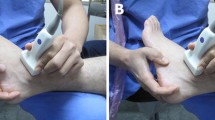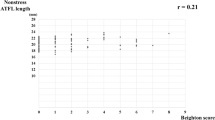Abstract
Purpose
To diagnose chronic anterior talofibular ligament (ATFL) injury, three different physical examinations were compared: the anterior drawer test (ADT), the anterolateral drawer test (ALDT), and the reverse anterolateral drawer test (RALDT).
Methods
A total of 72 ankles from potential ATFL-injured patients and the normal population were included and examined using the ADT, ALDT, and RALDT by two examiners without knowing the injury histories of any of the participants. Ultrasound examination was then applied as the gold standard to divide the ankles into the ATFL-injured group and the control group. The sensitivity (Se), specificity (Sp), false negative rate (FNR), false positive rate (FPR), accuracy, κ value, and p value of the two examiners’ diagnoses were calculated to assess the diagnostic ability of each examination.
Results
There were 38 ankles in the injured group and 34 ankles in the control group. No significant difference was found between the two groups in terms of gender, age, body mass index (BMI), and included ankles. In the ADT and ALDT groups, the specificity reached one, while the sensitivity was relatively low (0.053 and 0.477 for the junior examiner and 0.395 and 0.500 for the senior examiner). In the RALDT, both the sensitivity and specificity were greater than 85% (0.868 and 0.912 for the senior examiner and 0.921 and 0.882 for the junior examiner). The κ value of the RALDT (0.639) was higher than that of the ALDT (0.528) and the ADT (0.196), whereas all the p values were less than 0.05.
Conclusion
The ADT and ALDT are valuable physical tests to assess ATFL injuries. Compared with the traditional ADT and ALDT, however, the RALDT is more sensitive and accurate in diagnosing chronic ATFL injuries.
Level of evidence
II (diagnostic).



Similar content being viewed by others
References
Anandacoomarasamy A, Barnsley L (2005) Long term outcomes of inversion ankle injuries. Br J Sports Med 39:e14 (discussion e14)
Boruta PM, Bishop JO, Braly WG, Tullos HS (1990) Acute lateral ankle ligament injuries: a literature review. Foot Ankle 11:107–113
Brostrom L (1966) Sprained ankles. V. Treatment and prognosis in recent ligament ruptures. Acta Chir Scand 132:537–550
Brozek J (1966) Fechner G-elements of Psychophtsics. Am Sci 54:A359
Cao S, Wang C, Ma X, Wang X, Huang J, Zhang C (2018) Imaging diagnosis for chronic lateral ankle ligament injury: a systemic review with meta-analysis. J Orthop Surg Res 13:122
Chow S-C, Wang H, Shao J (2007) Sample size calculations in clinical research. CRC Press, Boca Raton
Croy T, Koppenhaver S, Saliba S, Hertel J (2013) Anterior talocrural joint laxity: diagnostic accuracy of the anterior drawer test of the ankle. J Orthop Sports Phys Ther 43:911–919
Dieter KC, Hu B, Knill DC, Blake R, Tadin D (2014) Kinesthesis can make an invisible hand visible. Psychol Sci 25:66–75
Fujii T, Luo ZP, Kitaoka HB, An KN (2000) The manual stress test may not be sufficient to differentiate ankle ligament injuries. Clin Biomech (Bristol, Avon) 15:619–623
Gescheider GA, Thorpe JM, Goodarz J, Bolanowski SJ (1997) The effects of skin temperature on the detection and discrimination of tactile stimulation. Somatosens Mot Res 14:181–188
Glasgow M, Jackson A, Jamieson AM (1980) Instability of the ankle after injury to the lateral ligament. J Bone Joint Surg Br 62-b:196–200
Goldreich D, Peterson MA (2012) A Bayesian observer replicates convexity context effects in figure-ground perception. Seeing Perceiving 25:365–395
Gomes JLE, Soares AF, Bastiani CE, de Castro JV (2018) Anterolateral talar palpation: a complementary test for ankle instability. Foot Ankle Surg 24:486–489
Gribble PA, Bleakley CM, Caulfield BM, Docherty CL, Fourchet F, Fong DT et al (2016) 2016 consensus statement of the International Ankle Consortium: prevalence, impact and long-term consequences of lateral ankle sprains. Br J Sports Med 50:1493–1495
Gribble PA, Bleakley CM, Caulfield BM, Docherty CL, Fourchet F, Fong DT et al (2016) Evidence review for the 2016 International Ankle Consortium consensus statement on the prevalence, impact and long-term consequences of lateral ankle sprains. Br J Sports Med 50:1496–1505
Hiller CE, Nightingale EJ, Raymond J, Kilbreath SL, Burns J, Black DA et al (2012) Prevalence and impact of chronic musculoskeletal ankle disorders in the community. Arch Phys Med Rehabil 93:1801–1807
Hua Y, Yang Y, Chen S, Cai Y (2012) Ultrasound examination for the diagnosis of chronic anterior talofibular ligament injury. Acta Radiol 53:1142–1145
Lahde S, Putkonen M, Puranen J, Raatikainen T (1988) Examination of the sprained ankle: anterior drawer test or arthrography? Eur J Radiol 8:255–257
Lloyd K, Leslie DS (2013) Context-dependent decision-making: a simple Bayesian model. J R Soc Interface 10:20130069
Marder RA (1995) Current methods for the evaluation of ankle ligament injuries. Instr Course Lect 44:349–357
Meyers-Levy J, Zhu R, Jiang L (2010) Context effects from bodily sensations: examining bodily sensations induced by flooring and the moderating role of product viewing distance. J Consum Res 37:1–14
Miller AG, Myers SH, Parks BG, Guyton GP (2016) Anterolateral drawer versus anterior drawer test for ankle instability: a biomechanical model. Foot Ankle Int 37:407–410
Phisitkul P, Chaichankul C, Sripongsai R, Prasitdamrong I, Tengtrakulcharoen P, Suarchawaratana S (2009) Accuracy of anterolateral drawer test in lateral ankle instability: a cadaveric study. Foot Ankle Int 30:690–695
Rasmussen O (1985) Stability of the ankle joint. Analysis of the function and traumatology of the ankle ligaments. Acta Orthop Scand Suppl 211:1–75
Santilli V, Frascarelli MA, Paoloni M, Frascarelli F, Camerota F, De Natale L et al (2005) Peroneus longus muscle activation pattern during gait cycle in athletes affected by functional ankle instability: a surface electromyographic study. Am J Sports Med 33:1183–1187
Seligson D, Gassman J, Pope M (1980) Ankle instability: evaluation of the lateral ligaments. Am J Sports Med 8:39–42
Treisman M, Lages M (2010) Sensory integration across modalities: how kinaesthesia integrates with vision in visual orientation discrimination. Seeing and Perceiving 23:435–462
van Dijk CN, Mol BW, Lim LS, Marti RK, Bossuyt PM (1996) Diagnosis of ligament rupture of the ankle joint. Physical examination, arthrography, stress radiography and sonography compared in 160 patients after inversion trauma. Acta Orthop Scand 67:566–570
van Dijk CN, Lim LSL, Bossuyt PMM, Marti RK (1996) Physical examination is sufficient for the diagnosis of sprained ankles. J Bone Joint Surg 78B:958–962
Vuurberg G, Hoorntje A, Wink LM, van der Doelen BFW, van den Bekerom MP, Dekker R et al (2018) Diagnosis, treatment and prevention of ankle sprains: update of an evidence-based clinical guideline. Br J Sports Med 52:956
Watanabe K, Kitaoka HB, Berglund LJ, Zhao KD, Kaufman KR, An KN (2012) The role of ankle ligaments and articular geometry in stabilizing the ankle. Clin Biomech (Bristol, Avon) 27:189–195
Funding
This work was funded by the National Science Foundation of China (Nos. 81572209).
Author information
Authors and Affiliations
Corresponding author
Ethics declarations
Conflict of interest
The authors declare that they have no conflicts of interest in the authorship and publication of this contribution.
Ethical approval
All procedures performed in this study involving human participants were in accordance with the ethical standards of the review board of Fudan University (Reference Number: KY2106-314).
Additional information
Publisher's Note
Springer Nature remains neutral with regard to jurisdictional claims in published maps and institutional affiliations.
Electronic supplementary material
Below is the link to the electronic supplementary material.
Rights and permissions
About this article
Cite this article
Li, Q., Tu, Y., Chen, J. et al. Reverse anterolateral drawer test is more sensitive and accurate for diagnosing chronic anterior talofibular ligament injury. Knee Surg Sports Traumatol Arthrosc 28, 55–62 (2020). https://doi.org/10.1007/s00167-019-05705-x
Received:
Accepted:
Published:
Issue Date:
DOI: https://doi.org/10.1007/s00167-019-05705-x




